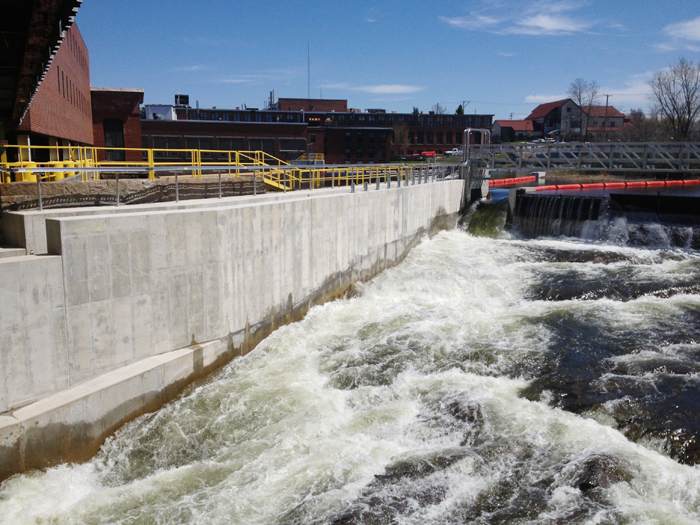WESTBROOK — The first of several fish passageways planned for the Presumpscot River officially opened Wednesday, just in time for alewives and other species to make migratory runs that could begin any day.
Sappi Fine Paper was required by the state to build the fishway at its Cumberland Mills Dam. Its opening represents a key step in a long-running effort to restore migratory fish runs that have been blocked for more than a century by a series of industrial dams.
Sappi held an opening ceremony and private tours of the $5 million fish ladder on Wednesday afternoon for city and state officials, conservation advocates and engineers and construction workers who were involved with the project.
Donna Cassese, manager of Sappi’s Westbrook mill, said alewives and other species that swim up the ladder this spring will access a part of the river that migrating fish haven’t reached in more than 150 years.
“So, big day for us,” she said.
The new fishway only opens an extra mile of river to the migratory fish, for now. Any fish that make their way over the Cumberland Mills Dam this spring will be held up at Saccarappa Falls, where Sappi has a hydroelectric dam. That dam must now have a fishway by May 2015, although the company is considering removing the dam entirely instead.
Eventually, Sappi will have to build fishways at its other four hydroelectric dams upriver, depending on how quickly the fish population builds up.
The five hydroelectric dams upriver from Cumberland Mills are regulated by the Federal Energy Regulatory Commission, which ordered Sappi to build fishways — a decision that the company appealed to the U.S. Supreme Court and lost.
However, passages at those five dams would not have opened up fish habitat because there was no fishway at the Cumberland Mills Dam, which does not generate power and is not regulated by the federal government. The dam is used to draw water for cooling and is regulated by the state. Conservationists have pushed for years to make the dam passable.
Sappi announced in 2007 that it would remove the dam, but pulled out of the plan a year later. In 2009, the commissioner of the state Department of Inland Fisheries & Wildlife ordered a fishway to be built there.
“We’re the first to admit this project has had some fits and starts,” Cassese said to about 50 people who attended the event Wednesday.
But, she said, Sappi is “dedicated to ensuring the long-term revitalization of the river’s use.”
The fish ladder, a channel that runs between two concrete walls along the side of the dam and the mill building, is 300 feet long and 4 feet wide. Tour guides led groups along the grated walkway above the flowing water, which is slowed by baffles so fish can proceed.
The ladder was designed to allow alewives, blueback herring and American shad — the worst swimmers of the migratory fish on the river — to get over the dam. Once they’ve repopulated the river, predators such as striped bass and salmon could follow.
Between several baffles along the ladder are areas called resting pools, where the water is nearly still.
Mark Brown, maintenance and engineering manager for Sappi, said the fish can “hang out here, catch their breath and relax a little bit” before continuing up the channel, which rises more than 22 feet.
The ladder itself was only part of the $4.8 million project needed to make an effective passageway.
Sappi had to build a barrier dam near the entrance of the fishway channel, so the fish don’t pass by it. Old wooden gates at the dam were replaced with tighter steel ones to give Sappi better control over water flow in the river. And the level of the water can be detected by sensors that are connected to valves that can adjust the flow.
People who took tours of the fishway Wednesday said they were impressed, so far.
“I think they did a good job,” said Ivy Frignoca, an attorney with the Conservation Law Foundation, which advocated for the fishway. “I’m excited to see how it works,” she said.
Gail Wipplehauser, a scientist for the state Department of Marine Resources, echoed Frignoca. “It looks really nice,” she said. “It looks like it should work.”
Staff Writer Leslie Bridgers can be contacted at: 791-6364 or at
lbridgers@pressherald.com
Send questions/comments to the editors.




Success. Please wait for the page to reload. If the page does not reload within 5 seconds, please refresh the page.
Enter your email and password to access comments.
Hi, to comment on stories you must . This profile is in addition to your subscription and website login.
Already have a commenting profile? .
Invalid username/password.
Please check your email to confirm and complete your registration.
Only subscribers are eligible to post comments. Please subscribe or login first for digital access. Here’s why.
Use the form below to reset your password. When you've submitted your account email, we will send an email with a reset code.